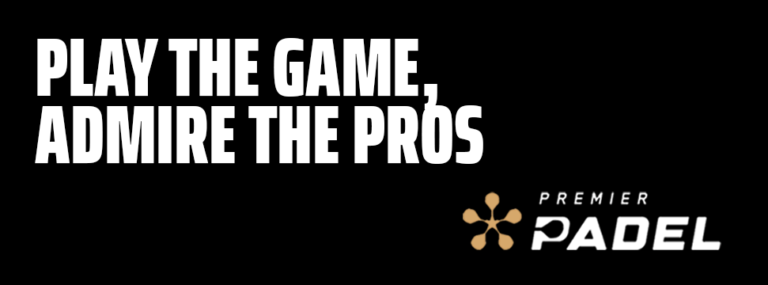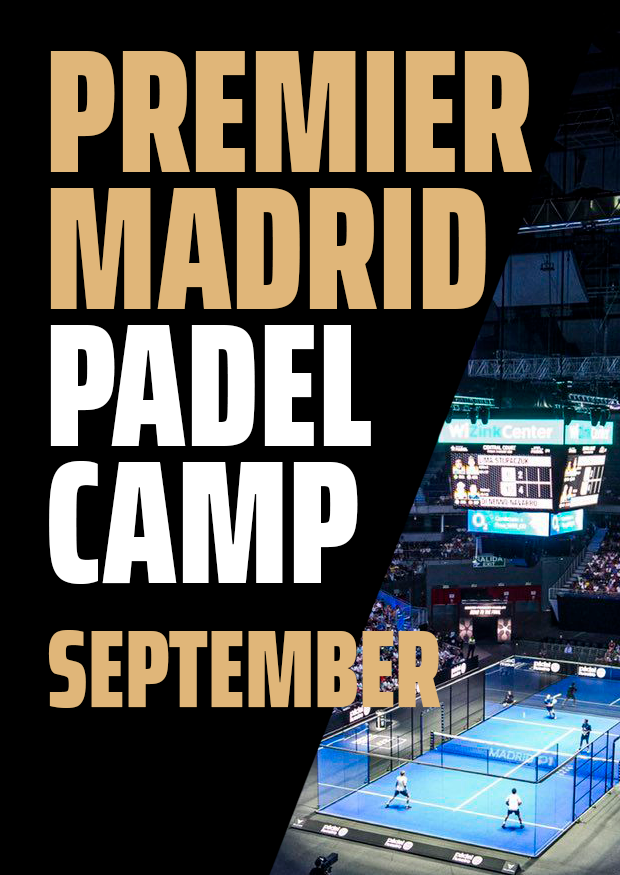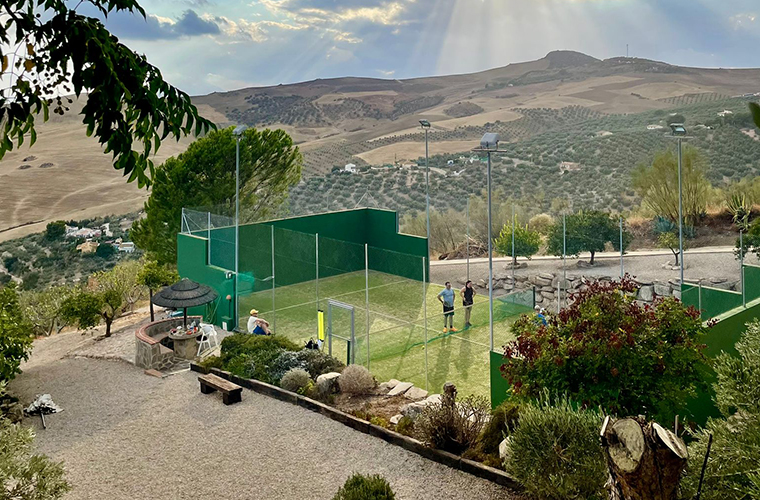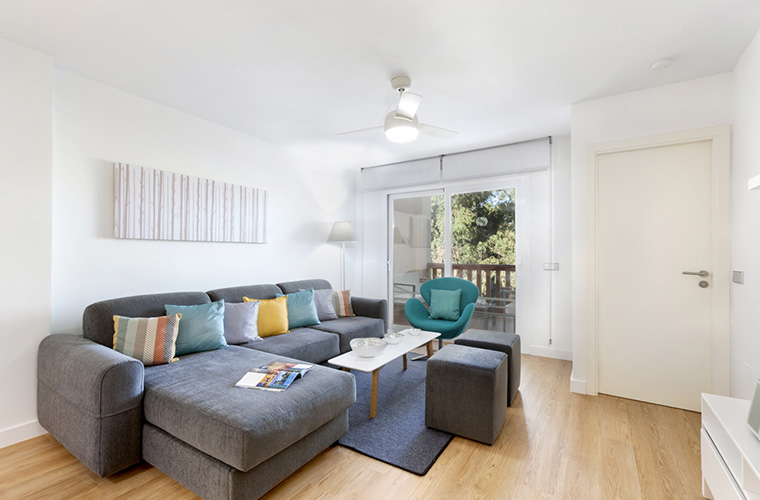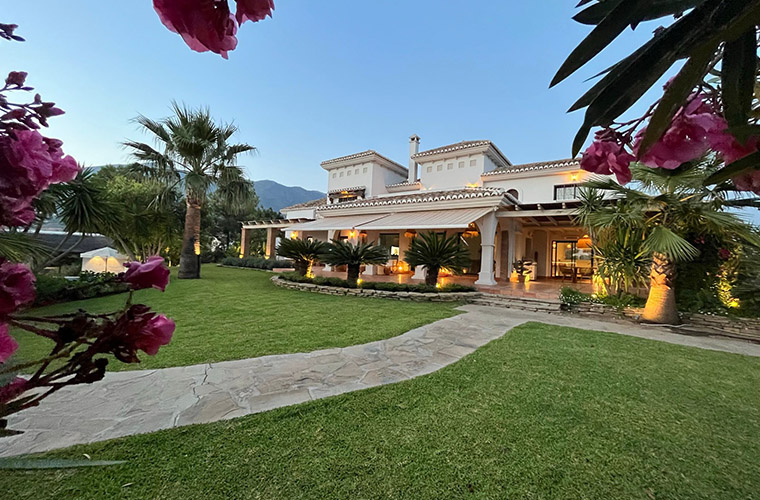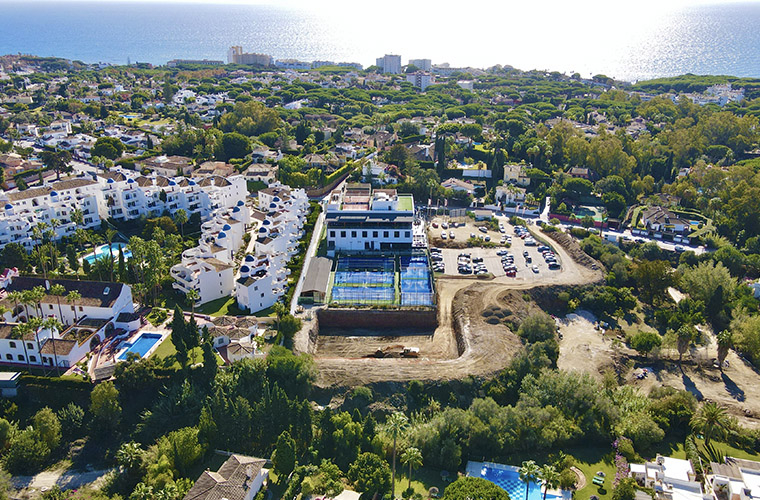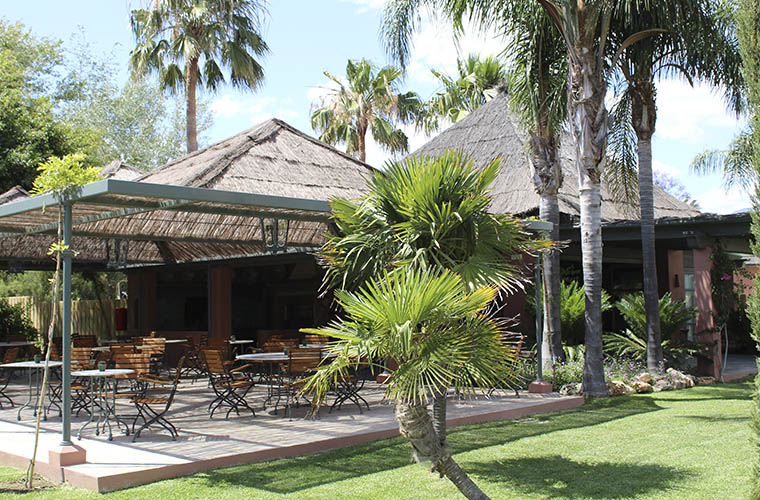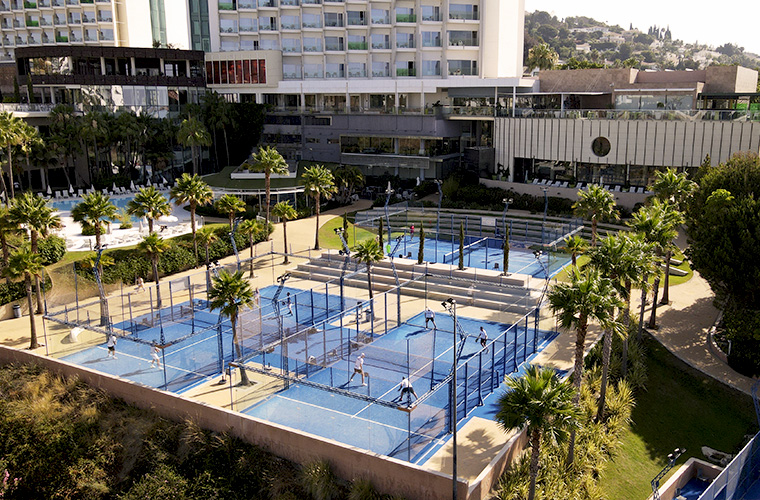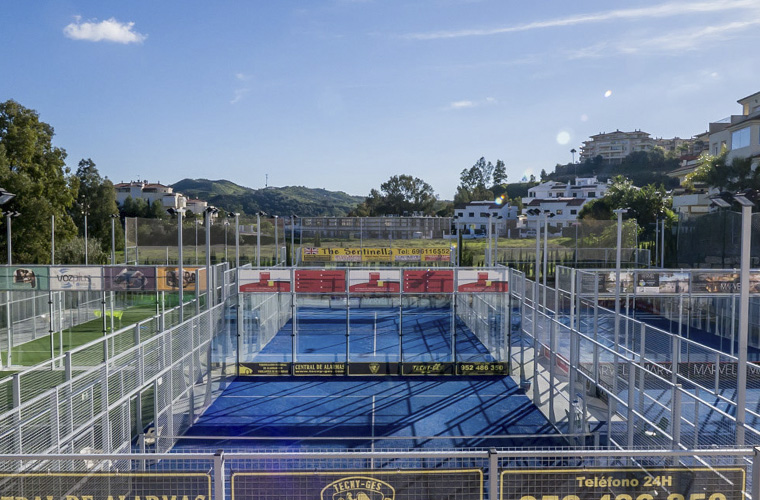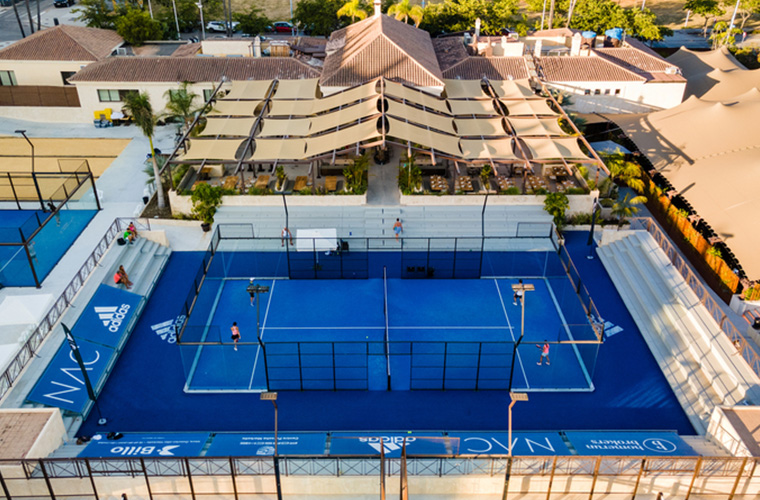THE COMPLETE AND OFFICIAL REGULATION OF PADEL RULES FROM THE INTERNATIONAL PADEL FEDERATION
Padel tennis is a sport where the player can hit the ball in different ways, such as before it bounces, after the ball bounces once on the ground, or even after bouncing off the wall.
Perhaps rules like these can make you think that paddle tennis is a complicated sport, but the truth is that knowing the most basic rules the reality is that paddle tennis is a very fun sport.
It is enough to enter the court in order to pass the ball to the opposite field and enjoy this wonderful sport.
We recommend you start by looking at the summary of the most important rules that we mentioned in this article and you will be ready to start playing.
If you want more information, you can have a quick understanding of how to play padel in the videos below.
FORWARD
The International Padel Federation (henceforth known as IPF) is the governing body of the game of padel. Included among its obligations is to determine the Rules of the Padel.
The IPF Rules and Regulations Committee will continually monitor the game and when it considers it necessary recommend changes at the General Meeting, which is the ultimate authority when making any changes to the Rules, in abidance with the Bye-Laws.
Note: Except when stipulated otherwise, all references to “player” in these Rules relates to both male and female players.
VIDEO
Padel rules
Padel tennis regler
Padel regler
Padel spelregels
LINKS & PDF
Padel spelregels en normen – Dutch PDF
DIE SPIELREGELN VON PADEL TENNIS – GERMAN
Oficial Padel Rules by IPF – English PDF
You can read this article with the basic padel rules:

THE COURT
DIMENSIONS
The court is a rectangle 10 metres wide by 20 metres long (interior measurements) with a 0.5% tolerance.
This rectangle is divided in half by a net. On either side of and parallel to the net at a distance of 6.95 m are the service lines. The area between the net and the service lines is divided in half by a perpendicular line called the central service
line. The central service line will extend 20 cm beyond the service line.
When referring to surface and line layout, the two halves of the court must be absolutely symmetrical. All lines must have a width of 5 cm. The colour of the lines are preferably white or black, for better contrast with the colour of floor
surface.

Minimum height must be 6 metres throughout the court.
With no elements (i.e. spotlights) which obstruct this area.
As for the new facilities it is suggested that the minimum free height should be of 8 metres throughout the court, with no elements of obstructionin this area.

NET
The net must be 10 metres long and 0.88 high at the centre, rising to 0.92 metres at the ends, with a maximum tolerance of 0.005 metres.

The net is suspended by a metal cable with a maximum diameter of 0.01 metres; the ends are attached to two lateral posts with a maximum height of 1.05 metres. Or a part of the court structure which allows the correct suspension and tension.

The mechanism used to give the cable tension in the net must be designed in such a way that it cannot loosen unexpectedly or constitute a risk to the players.
The outer side of the net posts should coincide with the lateral limits of the court, (opening, entrance or metallic fence). They may be circular or square but must have rounded edges.
The net must be capped with a white strip measuring between 5.0 & 6.3 cm once in place, with the tension cable beneath it. This surface may be used for advertising, and an additional strip up to a width of 9.00 cm may also be added.

The outer side of the net posts should coincide with the lateral limits of the court, (opening, entrance or metallic fence). They may be circular or square but must have rounded edges.
The net must be capped with a white strip measuring between 5.0 & 6.3 cm once in place, with the tension cable beneath it. This surface may be used for advertising, and an additional strip up to a width of 9.00 cm may also be added.

The net must be fully extended so that it fills the space between the two net posts and the court urface, there may be no spaces between the extremes of the net and the posts. However, it should not be tense.
Case 1: Can there be a space between the metallic fence and the net post ?
(see diagram)
Decision: NO. This court is not built according to the regulation
The net mesh must be made of synthetic fiber and the weave sufficiently narrow so that the ball cannot pass through it

ENCLOSURES
The court must be completely enclosed. The ends measured from the inside must be 10 metres long and the inside length of the sides 20 metres long.
All areas with joins must be constructed using materials that allow a uniform bounce of the ball and in areas with metal fencing where the bounce is not uniform in the following manner:
ENDS
A total height of 4 metres the first 3 m of which is wall, that could be of any transparent or solid material (crystal, bricks, etc.) but with characteristics must be complaid with the requests indicated in section “Sides” for walls, and the last 1 metre is metallic fence.

SIDES
Regulation allows two variations on the lateral/side enclosures:
Variant 1
Made up of stepped wall areas at both ends, the first step 3 metres high x 2 metres long and the second step 2 metres high x 2 metres long. Areas of metallic fencing complete the enclosure of up to 3 metres in the centre 16 metres and up to 4 metres at both ends.
Variant 2
Made up of stepped wall areas at both ends, the first layer 3 metres high x 2 metres long and the second layer 2 metres high x 2 metres long. Areas of metallic fencing complete the enclosure of up to 4metres along the length.
The dimensions given are from the inside of the court


The metallic fencing is always placed in line with the inner side of the wall.
In the case the metalic fencing is fixed to a frame, it’s upper part must be free of elements that are not part of the metalic structure (i.e.: cables, electrical boxes, light devices, etc.).
The walls may be made of any transparent or opaque material (glass, brick, etc.) but always with the correct consistency and which ensures a uniform bounce of the ball. Whatever the material it must have a uniform surface which is hard and completely smooth and which allow bodily contact or sliding balls. The colour of opaque walls should be of one, uniform color and preferably of green, blue or terracotta tone, and clearly different than the floor surface colour. It will be allowed the logo imprinting or painting but not more than one for single wall and with dimension and colours that do not interfere with player’s vision.
Glass courts must comply with the standards for tempered/plate glass:
– European Union: EN 12150-1.
– Other countries: Should consult their own standards.
The metallic fence should be made up of rhomboids or squares simply twisted or soldered but always with holes (diagonal measurement) no smaller than 5 cm and no larger than 7.08 cm. Recommended thickness of the wire is between 1.6 mm and 3 mm. With a maximum of 4 mm and a tension which allows the ball to bounce on it.
If a soldered fence is used all points of solder must be protected on both sides as to ensure against cuts or scratches. If the soldered mesh is not interlaced it must be in squares not rhomboids. The parallel metal threads must be on the inside and the vertical threads on the outside.
If the fence is simply twisted the torsion mechanism must be on the outside of the court and conveniently protected. The joins or seams must not have any sharp or pointed edges.
Both types of metallic fence must form a flat and vertical surface and must ensure that the above characteristics are always maintained.
Case 2: If it is deemed necessary to increase the height of the metallic fence over and above the stipulated limits (variant 1 and 2) to avoid the ball leaving the court. A white metal strip should be placed at either 3 m or 4 m correspondingly to clearly differentiate a valid from non valid point during the match.
If the ball hits the white metal strip it is considered out.
GROUND SURFACES
The surface of the court should be and may be made of porous concrete or cement, synthetic material or artificial grass, provided that it allows a regular bounce of the ball and avoids the accumulation of water.
Permitted and preferred colours are green, blue or terracotta, or their various like tones and be only one and uniform for the whole floor surface, and clearly different than the wall surface colour.
The black floor surface colour could be accepted only for in-door facilities.The surface level should be such that the differences in the inside levels are less than 3 mm measured with a rule of 3 m (1/1000).
For surfaces without drainage the maximum transverse evacuation slope must be 1% from the centre towards the outer edges of the court.
Case 3: In non draining surfaces a 0% slope will be accepted.
For synthetic and artificial grass surfaces the following requisites must be
complied with:
– European Union: Conforming to the UNE 41958 IN. Sports surfaces.
– Other countries: Should consult their own standards.
REQUISITES
Impact Absorption (Force reduction) → RF ≥ 20% → Artificial grass.
Friction → 0,4 ≤ µ ≤ 0,8 → Artificial grass.
Vertical bounce of the ball → ≥80% → Artificial grass and syntetic surfaces.
Sand refill → SiO2 ≥ 96% CaO ≤ 3% Rounded edges Granulometry: 80% weight Ø 16 mm-1.25 mm Visible fibre length 2mm-3mm → Artificial grass
ACCESS
Access to the court are placed in both of the lateral sides or just in one of them, and must be symmetric with the centre. There may be one or two on each side, with or without a door (see rule 16 of the game, out-of-court play).
In in a court without door, it is installed onto the floor, in the area corresponding to the court access, some kind of metallic or other material beam or duct in order to reinforce the whole structure, it will be considered as part of the fence frame for any reference of application of the current regulations. In the case there are no any element installed onto the floor, the vertical projection of the fence frame will indicates the internal court edge, undependently if there are a signed or painted line or not.
Access dimensions must be as follows:
1) With one lateral access per side the opening must be a minimum of 1.05 x 2.00 metres and a maximum of 2.00 x 2.20 m (See diagram).

2) With two lateral accesses per side the openings must be a minimum of 0.72 x 2.00 m and a maximum of 1.00 x 2.20 m (See diagram).

NB: Public installations must comply with the access standards, suppression bars and arquitectural bars for disabled people.
In case of existing doors, the handles must be placed on the outside and not protrude on the inside.
SAFETY AREA & OUT-OF-COURT PLAY
For out-of-court play each side of the court must have 2 access points. There may not be any obstacles outside the court within an area of no less that 2 metres wide and 4 metres long on either side and a minimum of 3 metres high (seediagram).

The access must be protected in it’s three sides: lateral and upper sides, as well as the net post, with a product to cushion against player contact (i.e.: spongy rubber, rubber, neoprene, etc.) with a thickness not less than 2 cm. These
protections must be firmly fixed to the metal structure and to the posts, with enough fastening or velcro to guarantee the efficiency of the anti-shock cushion and also to reduce as much as possible the interference to the game due to it’s projection to the court inner space.
ILLUMINATION
Artificial light must be uniform and placed in a way that does not cause difficulties of vision for the players, the team of umpires or the audience. They must comply with the following standards:
– European Union: EN 12193 “Sports facility Illumination” and have the following minimum levels of illumination:
| MINIMUM ILLUMINATION LEVELS (OUT-DOOR) | HORIZONTAL ILLUMINATION E MED (LUX) | UNIFORMITY E MIN/E MED |
|---|---|---|
| National & International competitions | 500 | 0,7 |
| Local competitions, training, school and recreational use | 200 | 0,5 |
| MINIMUM ILLUMINATION LEVELS (IN-DOOR) | HORIZONTAL ILLUMINATION E MED (LUX) | UNIFORMITY E MIN/E MED |
|---|---|---|
| National & International competitions | 750 | 0,7 |
| Local competitions, training, school and recreational use | 300 | 0,5 |
– Other countries: Should consult their own standards.
Light poles must be located outside the court. If these fall within the safety area, the out of court game will not be allowed.
Lights must have a minimum altitude from the ground to the inferior part of the projectors of 6 metres.

As for the new facilities it is suggested they have a minimum height from the ground to the inferior part of the light projectors of 8 metres if they are installed inside the court considering the vertical projection of the court side walls.
Different heights for lighting can be installed for lights installed outside the court walls
For Television broadcasts and film recording a level of vertical illumination of at least 1000 lux is needed. However, this could increase with the distance of object from the camera.
For more information of the aforementioned consult the quoted standard.
ORIENTATION
Recommendation for the longitudinal axis of the court in outdoor facilities is N-S admitting a variation between N-NE and N-NW
THE BALL
The balls used for official competions are those approved by the I.P.F. for the game of Padel.
The ball should be a rubber sphere with a uniform exterior surface in either white or yellow. Its diameter should
measure between 6.35 y 6.77 cm and its weight between 56.0 y 59.4 grms. The bounce is understood to be between 135 y 145 cm when let fall onto a hard surface from a height of 2.54 m.
The ball must have an internal pressure of between 4.6 Kg and 5.2 Kg per 2.54 square cm.
When play is at an altitude of more than 500 m above sea level another type of ball may be used. These should be identical to the aforementioned except for in the bounce which should be more than 121.92 cm and less than 135 cm.
THE PADEL RACKET
The game is played with a racket manufactured in according with the following regulations.
The racket is made up of two parts: Head and handle
– Handle: maximum length: 20 cm, wide maximum (of throat, not considering the free space in between): 50 mm, maximum thickness: 50 mm.
– Head: variable length. The length of the head plus the length of the handle may not exceed 45.5 cm, maximum width: 26 cm, maximum thickness: 38 mm.
The total length of the padel racket, head plus handle, may not exceed 45.5 centimeters.
When conducting a control of racket measurements a tolerance of 2.5% in the
thickness will be allowed.
The hitting surface of the racket is perforated by an unlimited number of cylindrical holes each measuring between 9 and 13 mm in the centre area. Around the edge in an area of no more than 4 cm (measured from the edge of
the racket) the holes may have a larger diameter or a different shape with a variable length and width while this does not affect the essence of the game.
Both sides of the racket must be flat but may be smooth or rough.
The racket must be free of any objects or devices adhered to it that are not specifically used to limit or prevent deterioration, vibration and to distribuite the weight. As such they must be reasonable in size and positioning. The racket could be not represent a sort of confusion or disturb all the other players, then could not have any reflecting surface or sound elements that could in any way modify the normal development of the game.
The racket must have a non elastic cord of a maximum length of 35 cm fixed into the handle which must be put around the wrist as protection against accidents. Its use is obligatory.
The racket may not have any visible or audible device which could communicate,
warn or give instructions to the player, during the course of a game.
Case 1: During the course of the game, a player accidentally breaks their racket.
Can play continue under these circumstances?
Decision: Yes, unless the safety wrist cord has broken or the padel racket has
become dangerous
Case 2: Is the player allowed to use more than one rackets during a game?
Decision: Yes but not during a point.
Case 3: Can a battery that affects the playing characteristics be incorporated into the racket ?
Decision: No. A battery is prohibited. Like a solar cell or other similar accessories they are considered a power source.
RULE 1. SCORE IN A GAME
SCORE
On the first point won “15” will be called, on the second point won “30”, the third point “40” and the fourth “game”. Except, if each pair have won three points, at which time “deuce” will be called. The following point won “advantage” and if the same pair wins the next point they win the game. If the point is lost the score will return to “deuce”. And so on until one pair of players has won the two consecutive points which are needed to win the game.
The first pair to win 6 games, always with a minimum advantage of 2, will win the set. In the case of a tie (draw) at 5 games the players will have to play two more games, to win by 7-5. However, if there is a tie at 6 games a “tie-break” or sudden death will be applied.
The match is the best of three sets. Two out of three sets need to be won in order to win the match.
In the case of a tie of one set each, and always previously established, the third set may be played without a “tie-break” so, if there is a tie at six games, the pair who gain a difference of two games win.
SUDDEN DEATH OR “TIE-BREAK”
During tie-break, the points “zero”, “1”, “2”, “3”, etc., are called.
The “tie-break” will be won by the first players to win 7 points, as long as it is with a 2 point advantage and therefore the “game” and the “set”. If necessary tie-break continues until this margin is obtained.
The “tie break” will be started by the player whose turn it is to serve according to the order followed in the set. This player will only have one serve taken from the right side of court. The following two points will be served by the players of the opposite team respecting the previous order of service and serving from the left.
After this the players will serve two consecutive points until the end of “the tiebreak” always respecting the aforementioned order of service.
A “tie-break” set will be won by 7-6.
The following set will be started by the player of the pair who did not begin
serving in the “tie-break”.
Case 1: Who begins serving in a “tie break”?
– The player who began serving at the beginning of the set. Except under
circumstances as set out in Rule 6, section J.
ALTERNATIVE SCORING METHODS
MAKING A GAME
The “no advantage” (gold point) may be used as an alternative scoring method A match is scored with the marker calling. The score called is that of the server first
no point – “love”
first point – “15”
second point – “30”
third point – “40”
fourth point – “game”
If both pairs of players have won three points each “deuce” will be called and a deciding point named “gold point” will be played. The receiving pair will choose whether to receive the service on the right or the left side of the court. The
receiving pair cannot change positions to receive the deciding point. The pair that wins the point wins the match.
In mixed matches, in the deciding point the player receiving will be the same sex as the server. But the receiving players cannot change positions to receive serve.
SCORE IN A SET
FOUR GAMES OR MINI SET:
The pair to win four games wins the set, with a minimum margin of two games. If both pairs tie at four games each a tie-break will be played.
TIE-BREAK TO DEFINE THE MATCH (7 POINTS):
When the score is one set all, a tie-break game will be played to decide the winner. This tie-break is final and replaces the last set.
The first pair to win seven points wins the tie-break and the match, provided
there is a minimum margin of 2 points.
SUPER TIE-BREAK GAME TO DEFINE THE MATCH (10 POINTS):
When the score is one set all set, a tie-break game will played to decide the winner. This tie-break is final and replaces the last set.
The first pair to win ten points wins the tie-break and the match, provided there
is a minimum margin of 2 points.
Note 1: When the match “tie break” is used to replace the final set:
– The original order of service will continue, although the players may change
the order of the server and that of the receiver.
Note 2: Balls will not be changed at the start of the “tie break” even if a ball
change is due.
RULE 2. TIMES
The tournament umpire will award a “walk over” (WO) match lost, against players who are not on court ready
to play 10 minutes after the official start time of the match. Except in cases which the umpire considers a “force majeure”.
Case 1: When scheduling matches one after the other. The start of the following match is considered to be 5 minutes after the end of the previous one.
There will be an obligatory 5 minute warming up between players.
As per the norm, the match should be continuous, from the moment it begins (first service) until it finishes. Therefore a match should never be suspended or delayed to allow a player to recuperate, receive instructions or advice.
- A maximum of twenty (20) seconds is allowed between points.
- A maximum of ninety (90) seconds will be granted for changing sides. After the first game of each set and during a tie-break, play will be continuous and the players will change ends without a rest period.
- A maximum rest period of one hundred twenty (120) seconds will be granted at the end of each set.
The aforementioned rest time starts from the moment one point finishes until the following point begins with the serve.
If due to unforeseen circumstances a players clothing, shoes or equipment needs to be replaced an additional period of time (within reason) will be allowed for the player to solve the problem.
An announcement may be made before the match allowing a limited number of
restroom breaks or for a change of clothes.
20 seconds will be granted for changes of side in a “tie break”.
If a match has to be suspended due to rain, lack of light, accidents, etc., when the match restarts the players have the right to a warm up in agreement with the following:
a) up to 5 minute suspension. No warm up.
b) 5 to 20 minute suspension. 3 minute warm up.
c) Over 20 minute suspension. 5 minute warm up.
The match will begin exactly where it ended before it was suspended. With regard to: the game, score, player to serve, same place on the court and same order of serve and return.
If suspension is due to the lack of light, the match should be stopped at an even number of games in the set being played, so that when the match is resumed both pairs are on the same side they were on when play was stopped.
In the case of injury or a treatable medical condition the player will be granted one 3 minute break for treatment, which may be repeated in the following two changes of side but within the regulation time. If the injury is during the change of side the player may receive medical attention of the aforementioned 3 minutes and may repeat the process during the following two changes of side but within the regulation time.
Medical attention will only be given once to each player and may not be ceded to their companion.
In case of an accident as an indirect result of the game, but which affects one of the players, the tournament umpire may use their discretion to grant a period of time for treatment not in excess of 15 minutes.
If a player has a bleeding wound they will not be able to continue the match.
Case 1: In the case of an indirect accident to a player who then needs medical attention does this count as one of the allowed times? Decision: NO. It does not.
Case 2: How much rest time or interruption can there be between the first and second service Decision: None, the game must be continuous.
RULE 3. POSITION OF THE PLAYERS
Each pair of players will be on either side of the net on the court. The player who is serving (server) puts the ball in play and the player diagonally in front of said player (receiver) receives the served ball.
The player who receives can be in any part of their side of the court, as can their partner and the servers partner.
Case 1: Can a player be outside the court during the service?
Decision: NO.
Case 2: Is one of the pair of players allowed to monopolize the whole game?
Decision: YES, if the player remains in their court. But all players must serve and receive according to the regulations when it is their turn.
RULE 4. CHOICE OF ENDS AND SERVICE
The choice of ends or sides, who serves first and who receives should be decided by the flip of a coin. The pair who wins the toss may choose between:
a) Serving or receiving first. In which case the other pair will choose the side.
b) End (Side) of the court for the first game. In which case the other pair may
choose to serve or receive.
c) Request that the opponents choose first.
Once the order of serve and the ends (sides) have been decided, both pairs tell
the umpire who will be the first to serve and receive.
Case 1: Do players have the right to choose again if play is stopped during the
warm up and the players leave the court ?
Decision: Yes. The result of the original toss remains, but a new choice may be
made by both players.
RULE 5. CHANGES OF END
Players must change ends (sides) after the 1st, 3rd and every subsequent odd game in the set.
In the “tie break” the players will change ends (sides) after every 6 points.
If case of error and the players do not change ends (sides), the correction should be made as soon as the mistake is discovered, following the correct order. All points won before the error was discovered are valid. In the case that the mistake is discovered after a faulty first serve is taken, the server only has one serve remaining.
Case 1: At the end of a set we have a 120 second rest period. Do we have to
change ends (sides) to start the next set ?
Decision: If the total number of games played up to rest period add up to an odd
number, YES. If they add up to an even number, NO.
Case 2: At the end of the 1st game of each set we have to change ends (sides).
Are we allowed a rest period ?
Decision: NO, the game must be continuous.
RULE 6. THE SERVICE
All points begin with the service. If the first service is not valid the server is allowed a second service. It must take place as follows:
a) At the start of the service the player serving must stand with both feet behind the service line, between the imaginary prolongation of the central line of serve and the sidewall (service box) and must remain there until the
ball has been served.
b) The server must bounce the ball on the ground within the service box in which they find themselves to carry out the serve.
c) The server may not touch the service line with their feet, nor the imaginary central line.
d) The height of the ball being served must be at or below the waist level at the moment of hitting it, and the player must have at least one foot in contact with the ground.
e) The ball is served from te right side of the court it should pass diagonally over the net towards the receiving box of service of the person receiving the ball. It must bounce wihin the lines that limit this box. In the first instance the serve must go into the receiver’s box located at his left side, and, when one side wins the point, it is time for the following service and the ball must go into the receiver’s box located at his right side, and so on alternatively.

f) A player may not walk, run or jump while serving. Small foot movements which do not affect the adopted service position will be accepted.
g) At the moment contact is made with the ball, or in an intentional attempt to hit it, it will be considered a serve.
h) If a service is inadvertently made from the wrong side, the error will have to be corrected as soon as is discovered. All points are valid, but a fault on the first service must be taken into account.
i) Before starting each set the players may choose which one of them will serve first during the set. Once the order has been established it may not be changed until the beginning of the following set.
j) If a player serves out of turn, the player who should have served must do so as soon as the error is discovered. All points won before the error are valid. If there has been a single service fault up to the time of the error it will not be taken into account. In the case that the game has finished before the error is discovered the order of serve will remain as is until the conclusion of the set.
k) The server will not serve until the player receiving is ready. However, the player receiving will adapt within easonable to the rhythm of the server and will be ready to receive the service when the server is ready to serve.
l) It will not be possible to allege a “not ready” call if an attempt has been made to return the serve. Conversely if it can be shown that the receiver was not ready, a “fault” cannot be called.
Case 1: What is the maximum height a player who bends their leg can hit a ball
at when serving ?
Decision: At or below the height of their waist at that moment.
RULE 7. SERVICE FAULT
The Service is a fault if:
a) The server infringes Rule 6 “The Service”, points a) to f).
b) The server misses the ball when trying to hit it.
c) The ball bounces outside the receiver’s service box (the lines are counted as good).
d) The ball hits the server, his companion or any object worn or carried by either.
e) The ball bounces in the receiver’s service box and touches the metallic fence around the court before the second bounce.
f) The ball bounces in the receiver’s service box and bounces out of courtMdirectly through the gates of a court without a safety zone and therefore with no out-of-court play authorized.
Case 1: I’ve served and the ball hits the wall, a light or the fence on my side of the court, then gone over the net into the receiver’s service box before bouncing on the ground. Is this serve good ?
Decision: NO, it’s a fault.
Case 2: I have served a lob and the ball bounces in the receiver’s box and goes
directly out of court over the metallic fence. Is this a fault ?
Decision: NO
RULE 8. RETURN OF SERVE
a) The player who receives will have to wait for to the ball to bounce within their receiving box of service and hit it before it bounces on the ground for the second time.
b) The receiving players in first game of each set will decide who will be the first to receive; this player will continue receiving the first service of each game until the end of the set.
Each player will receive serve alternatively during the game and once the order has been decided it may not be altered during that set or tie-break but may at the beginning of a new set.
If during a match or tie-break, the receiving order is altered by the receiving players, they will have to continue in this manner until the end of the game or tie-break in which the mistake occurred. In the following games of that set, the players will adopt the positions initially selected.
c) If the ball hits one of the receiving players or their rackets while receiving a
serve before it bounces it will be considered a point in favour of the server.
Case 1: In the case of the old courts with vertical peaks in the join between the wall and the metallic fence i.e. the wall and the fence are not on the same plane, when the ball hits the “corner” or “ledge”, the service will only be considered valid if; After bouncing on the ground and hitting the mentioned “ledge”, comes out at an angle in the direction of the receiver the limit being the imaginary line that runs from the ledge to the other (see diagram).

Case 2: If the ball bounces twice within the receiver’s service box, even if between bounces it touched the wall, it is considered a point for the server.
Case 3: The player receiving the ball may not play a volley even if they find themselves outside the service reception box.
RULE 9. REPEAT OR “LET” AND “NET” SERVICE
The service will be “net” if:
a) The ball served touches the net or the supporting posts and then lands in
the receiver’s service box, as long as it does not touch the metallic fence
before the second bounce.
b) The ball after touching the net or posts (if these are within the game area)
hits any player or article carried or worn.
The service will be repeated (let) if:
c) The ball served when the receiver is not ready (Rule 6 k).
If there is a “let” on the first serve, it should be the complete point repeted, then
the server has the right to have two (2) serves.
If the “net” or “let” is on the second serve, the server will have only the right to
repeat the second serve.
Case 1: I put the ball in play, it touches the net and the first bounce is in the receiver’s box, with the second bounce the ball goes out of court through the opening. Is this “let” or fault ?
Decision: A “let” if the ball can be played outside the court. If not it is a fault.
RULE 10. REPETITION OR “LET” POINT
A point in dispute is a “let” if:
a) The ball splits during the game.
b) Any element not part of the game invades the court area.
c) In general, any interruption to the match due to unexpected situations unconnected to the players.
If a player considers that according to regulation a “let” situation has arisen they must let the umpire know immediately. If the play continues the player loses the right to a “let”.
Once the “let” has been requested the Umpire decides if it is appropriate. If not
the player loses the point.
Case 1: What happens if my first serve is a fault, during the point after the second serve a “let” is called ?
Decision: The whole point is repeated with the right to 2 serves.
RULE 11. INTERFERENCE
Interference is when a player with a deliberate or involuntary action, puts off an opponent during the execution of a shot. The Umpire, in the first instance, “deliberate interference”, will award the point to the opponent, and in the second case, “involuntary interference”, a “let” will be called and the point repeated.
RULE 12. BALL IN PLAY
The ball will be hit alternately by each pair of players.
The ball will be in play from the moment in which a valid service takes place until “let” is called or the score determined.
If the ball in play hits any part of the court after having bounced in the opponent’s ground, it will remain in play and should be returned before it bounces for the second time.
Parts of the court as mentioned above refer to the insides of the walls, the metallic mesh fence that encloses the court, the ground, the net and net posts.
The mesh and frame in its entirety will be considered as part of the fence.
Case 1: If the ball hits the fence frame in the upper part, the game has to be continued ?
Decision: If the ball bounds in the upper part of the fence frame “is good” and the game has to be continued, either in the case the ball comes back to the internal side of the court, or goes out to the court and it is allowed the out-of-court play.
RULE 13. POINT LOST
Players will lose a point if:
a) Either of the players, their rackets or anything worn or carried touches the net, net posts, the tension cable or any part of the opponent’s court while the ball is in play.
1. Authorized out-of-court play. Above 0.92 metres, and only if authorized, the dividing vertical post in the doors is considered a neutral zone for any of the four players, they may touch or hold on to it.
b) The ball bounces for a second time before being returned.
c) When the ball, after bouncing, goes over the marked limit (outer perimeter) of the court (lateral or end) or through the gate.
1. Authorized out-of-court play. When the ball, after bouncing correctly, goes out of court over the end wall. If it goes over the sidewall or through the door the point is lost when the ball bounces for a second time or touches any element not related to the court.
d) If the player hits the ball before it has gone over the net.
e) If a player returns the ball, either directly or hitting it off the walls of their court and without bouncing first it hits the walls of the opponents court, the metallic fence or any element not related to or located on the ground of the
opponents court.
f) If a player returns a ball, either directly or off the walls of their court and the ball hits the net or net posts and then directly onto one of the walls of the opposite court, the fence or any element not related to or located on the ground of the opponents court.
g) If a player hits the ball twice. (Double hit).
h) If after hitting the ball it touches the player playing the ball, their companion or anything worn by the players.
i) If the ball hits any part of the players or their equipment apart from the racket after being hit by the opposing team.
j) If a player hits the ball and it touches the metallic fence, any part of the ground on their own side of the court, or any element not related to the court located on the ground on their own side of the court.
k) If the ball is hit with a racket thrown at it.
l) If any player jumps over the net while the point is being played.
m) If both players simultaneously or consecutively hit the ball, the point will be lost. The ball may only be played by one member of the team.
NB: It is not considered a double hit when a pair of players tries to hit the ball simultaneously, one hits it and the other hits their team mate’s racket.
n) If the player who hits the ball has one, both feet, or any part of the own body out of their court. Unless out-of-court play has been authorized.
o) A player serves two consecutive faults
Case 1: What happens if the ball after bouncing correctly in my court does not bounce out of court due to the additional net that is sometimes put above the metallic fence ?
Decision: You have lost the point.
RULE 14. CORRECT RETURN
The return is correct if:
a) After being hit the ball is volleyed by either one of the opposing team. Or if it hits any part of the opposing team’s body, clothing or even the racket.
b) The ball after being hit bounces directly into the opposing court or hits the wall in the players own court first and it then bounces into the opponent’s court.
c) The ball bounces in the opponent’s court and then hits the metallic fence or one of the walls.
d) As a result of the direction and force with which the ball is hit, it bounces in the opponent’s court and then goes out of court, hits the ceiling, the lights or any other object not related to the court.
e) The ball touches to the net or net posts, and then lands in the opponent’s court.
f) The ball in play hits an object located on the ground of the opponents court not related to or part of the court (e.g. another ball).
g) After hitting the ball it bounces correctly into the oppositions court, goes back into the servers court at which moment the opposition player hits it. Always provided neither the player, nor any part of his clothing or racket has touched the net, posts or the opponents court of the opposites and the ball fulfills the stipulations indicated in points a) to f) above.
h) The ball is “scooped” or pushed it will be considered a correct return provided the player has not hit it twice, the impact takes place during the same movement and the natural exit of the ball does not vary substantially.
i) The returned ball bounces in the opponent’s court in the angle where the wall joins the ground (a corner). (This is familiarly called an “egg” and is considered valid).
j) Authorized out-of-court play. If the ball is hit from outside the court the return will be valid if the points previous to this Rule are fulfilled.
Case 1: According to point f) if the ball bounces on an object on the ground of the
opponents court the return is correct. And in addition I’ve won the point ?
Decision: No, the game continous.
RULE 15. POINT WON
a) If after bouncing in the opponent’s court the ball goes out of court through a hole in the metallic fence, or gets stuck in said hole.
b) If after bouncing in the opponent’s court the ball gets stuck in the flat horizontal surface on top of the wall.
RULE 16. AUTHORIZED OUT-OF-COURT PLAY
The players are authorized to leave the court to play the ball whenever the court fulfills the conditions established in the section pertaining to “The Court”, safety area and out-of-court play.
RULE 17. CHANGE OF BALLS
The competition organizers must announce the following in advance:
a) The make and model of balls;
b) The number of balls to be used in the match (2 or 3);
c) Ball change policy, if any.
Ball changes, if any should be made using one of the following alternatives for each match:
1. After an established odd number of games. The warm up period is counted as two games and the “tie break” as one, for the change of balls.
A ball change will not take place at the beginning of a “tie break”. In this case the change of balls will be delayed until the beginning of the second game of the following set.
2. At the beginning of a set.
In cases where ball changes should occur after an established number of games and are not, the error must be corrected when it is the turn of the team that should have served with new balls before the error occurred. After this the balls will be changed during the match as originally anticipated.
When a ball is lost, broken, or sufficiently deteriorated and differs from the others the Umpire will supervise a change with a ball in the same conditions as those in play. Otherwise, a complete match of balls of balls will be made. It is mandatory to have available at least two balls to start the point.
ETIQUETE AND CONDUCT NORMS
· PUNTUALITY
Matches will follow one after the other without delay as per the times displayed on match schedules. Match times will be published with sufficient time and players are obliged to inform themselves. The match order cannot be changed
without the authorization of Tournament Umpire.
· ATTIRE
Players will wear suitable sports clothing and footwear. Sleeveless t-shirts and/or swim wear are not allowed. Failure to comply will result in a fault being given. If not rectified the player will be disqualified.
Teams playing in competitions are recommended, although not obliged to wear the same clothing.
The players may use footwear, clothing, and the rackets they want to provided they are regulation.
In international tournaments the Umpires team must wear something which identifies them.
· IDENTITIFICATION
Participants will have to identify themselves giving their identity, nationality and age and in general any other documentation related to the competition when requested to do so by the Tournament Umpire.
Ball changes, if any should be made using one of the following alternatives for each match:
1. After an established odd number of games. The warm up period is counted as two games and the “tie break” as one, for the change of balls.
A ball change will not take place at the beginning of a “tie break”. In this case the change of balls will be delayed until the beginning of the second game of the following set.
2. At the beginning of a set.
In cases where ball changes should occur after an established number of games and are not, the error must be corrected when it is the turn of the team that should have served with new balls before the error occurred. After this the balls will be changed during the match as originally anticipated.
When a ball is lost, broken, or sufficiently deteriorated and differs from the others the Umpire will supervise a change with a ball in the same conditions as those in play. Otherwise, a complete match of balls of balls will be made. It is mandatory to have available at least two balls to start the point.
CONDUCT AND DISCIPLINE
Players will behave courteously and respect other people during any competition
whether taking part or not.
Coaches, like players will behave adequately, considering that the sanctions the
Umpire can apply to them at the match can be added to those of the players.
· MATCH AREA
Players may not leave the area of play during a match, including the warm up,
without the Umpire’s authorization. The area of play is understood as the court
and surrounding area.
· ADVICE AND INSTRUCTIONS
Players and teams may receive advice and instructions during a game from a
properly accredited coach, during competitions for teams and for double pairs, as
long as it takes place during rest times.
· PRIZE GIVING
The players or teams who play in the final of a match must participate in the prize
giving held at the end of the competition, unless they cannot due to a verified
injury, indisposition, or with reasonable cause.
· CONTINUOUS PLAY OR DELAYS
A match once started must be continuous and no player may delay it without
reasonable cause over and above the times permitted in Rule 2 of the present
Regulations.
· AUDIBLE AND VISIBLE OBSCENITIES
Audible obscenity is defined as the use of words well-known and understood to be
offensive and being spoken loud enough to be heard by the Umpire, spectators
and organizers of the competition.
Visible obscenities are defined as signs or gestures made with hands, rackets,
balls or any other part of the body that commonly have an obscene meaning or
offend reasonable people.
· BALL ABUSE
The players may not throw or hit the ball violently, in any direction, out of the
court, or at players on the other side of the net when not in play.
· RACKET OR EQUIPMENT ABUSE
Players may not at any time throw, deliberately hit any part of the court, ground,
net, Umpire’s chair, walls, metallic fence or any other element of the facilities
with their padel racket.
· VERBAL AND PHYSICAL ABUSE OR AGGRESSION
Aggressive, unsportsmanlike behavior, attitudes and gestures by players will be
treated with particular gravity, when made towards the Head Umpire, Umpire,
opponents, companions, spectators or any person related to the tournament. It
will be judged as verbal abuse, insults and likewise any oral expression that,
without being considered insulting is contemptuous or intrinsic to belittling
behavior.
· BEST EFFORTS
All the players must try their best to win the match in which they are
participating.
· UNSPORTSMAN LIKE CONDUCT
Players must at all times behave in a sportsman like manner avoiding any action
which goes against the sporting spirit, the competition or in general the respect of
established norms or fair play.
· PENALTIES / TABLE OF PENALTIES
Infraction during the course of the match of any of the aforementioned aspects will be sanctioned by the competition Judge/Umpire in agreement with the following Table of Penalties. Independent from the above the Competition
Committee will report in the Tournament-Act the arised situation and be able to ask the Disciplinary Committée to verify the possibility to impose other penalties for the same infraction, as a result of the application of the Sport Discipline Regulation.
Table of Penalties:
First infraction: Warning
Second infraction: Warning with point loss.
Third infraction: Warning with disqualification.
The infractions of both players and even of the accredited coach will be accumulated.
· DIRECT DISQUALIFICATION
In case of a very serious infraction (grave physical or verbal aggression) the Judge/Umpire will authorize the immediate disqualification of the player or coach who committed the fault. The disqualified player loses the match and may not continue in the competition. If an accredited technician, the captain or another player in the competition being held is disqualified they will have to withdraw from the tournament





